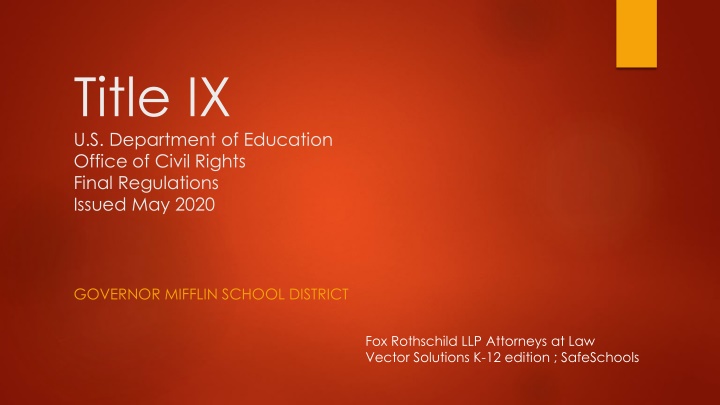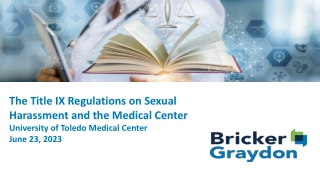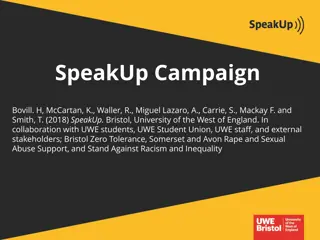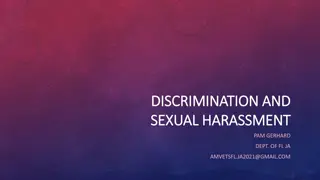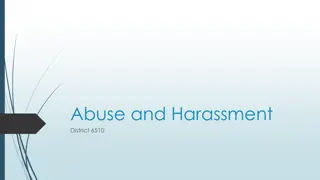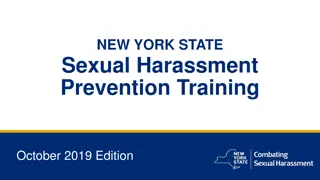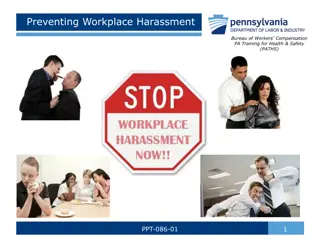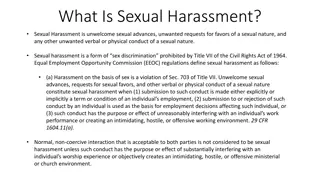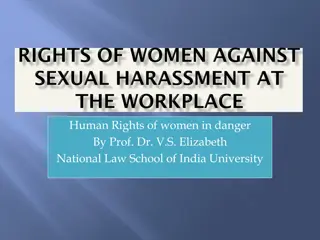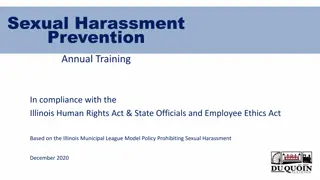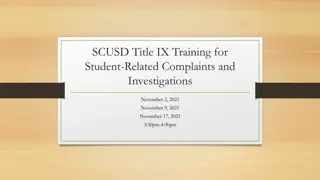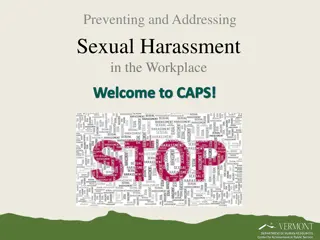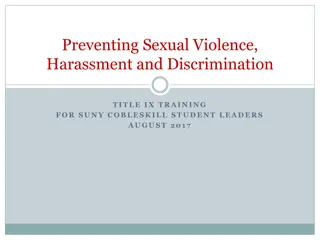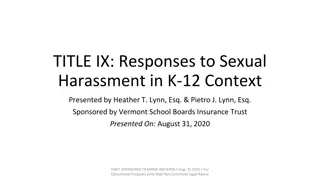Evolution of Title IX Regulations: From Athletics to Addressing Sexual Harassment in K-12 Education
Title IX, historically focused on providing equal opportunities in athletics, has expanded to address discrimination based on sex in all aspects of educational programming. The recent regulations emphasize combating sexual harassment and assault in K-12 schools, aligning with college and university requirements.
Uploaded on Sep 25, 2024 | 1 Views
Download Presentation

Please find below an Image/Link to download the presentation.
The content on the website is provided AS IS for your information and personal use only. It may not be sold, licensed, or shared on other websites without obtaining consent from the author.If you encounter any issues during the download, it is possible that the publisher has removed the file from their server.
You are allowed to download the files provided on this website for personal or commercial use, subject to the condition that they are used lawfully. All files are the property of their respective owners.
The content on the website is provided AS IS for your information and personal use only. It may not be sold, licensed, or shared on other websites without obtaining consent from the author.
E N D
Presentation Transcript
Title IX U.S. Department of Education Office of Civil Rights Final Regulations Issued May 2020 GOVERNOR MIFFLIN SCHOOL DISTRICT Fox Rothschild LLP Attorneys at Law Vector Solutions K-12 edition ; SafeSchools
Title IX is just Athletics, right? From the 1970 s until 2020 for High School or K-12 schools, Athletics was the primary focus for Title IX regulations. Ensuring underrepresented gender (females) were provided equal treatment, access and funding to male athletes. It has not resulted in loss of male sports, but has accomplished narrowing the gender gap in Athletic opportunities.
Title IX as it relates to Athletics required schools to:
We are not talking about Athletics anymore In 2020 Title IX was expanded to all areas of educational programing and now mirrors College/University requirements Title IX addresses loopholes in the Civil Rights Act of 1964: Discrimination on the basis of sex in educational institutions The Law governs how institutions MUST handle accusations of Sexual Harassment In Addition the Department of Education, Office for Civil Rights (OCR) provides oversight and investigation
Prelude to the New Regulations for K-12 Schools On February 26, 2020, U.S. Dept. of Education issued a press release about a renewed focus on combating sexual assault and sex harassment in K-12 schools. In fact, according to the most recent available Civil Rights Data Collection (CRDC) for the 2015-2016 school year, there were approximately 9,700 incidents of sexual assault, rape or attempted rape reported in public elementary and secondary schools. According to the Department, "The number of K-12 sexual harassment and violence complaints filed with OCR is nearly 15 times greater than it was a decade ago. This disturbing change is a matter of serious concern and requires immediate attention. https://www.ed.gov/news/press-releases/secretary-devos-announces-new-civil-rights-initiative-combat-sexual-assault-k-12- public-schools?utm_content=&utm_medium=email&utm_name=&utm_source=govdelivery&utm_term=
History of Title IX The Supreme Court in Franklin acknowledged that sexual harassment and sexual abuse of a student by a teacher may mean the school itself engaged in intentional sex discrimination.
History of Title IX (Contd) In Gebser v. Lago Vista Independent School District, the Supreme Court analyzed the conditions under which a school district will be liable for money damages for an employee sexually harassing a student. The Gebser court began its analysis by stating that while Franklin acknowledged that a school employee sexually harassing a student may constitute the school itself committing intentional discrimination on the basis of sex, the Gebser court held that where a school has actual knowledge of an employee sexually harassing a student but responds with deliberate indifference to such knowledge, the school itself has engaged in discrimination, subjecting the school to money damages in a private lawsuit under Title IX.
History of Title IX (Contd) Davis is a case concerning sexual harassment of a fifth-grade student by another student. The Supreme Court did not adopt the Title VII definition of sexual harassment (severe, persistent, or pervasive) for use under Title IX, defining actionable sexual harassment for Title IX purposes as conduct that is severe, pervasive and objectively offensive. The Department stated that it s persuaded by the Supreme Court s reasoning that elementary and secondary [S]chools are unlike the adult workplace and that children may regularly interact in a manner that would be unacceptable among adults The Department does not wish to apply the same definition of actionable sexual harassment under Title VII to Title IX because such an application would equate workplaces with educational environments.
New Regulations: They require all recipients (schools, LEAs, IHEs) to ensure that no student, employee or third party participating in or attempting to participate in an education activity or program is discriminated against based on sex. They do this by creating or revising Title IX procedures, identifying a Title IX Coordinator and other key personnel, training all key personnel, alerting all members of the school community about Title IX policies, and publishing the name of the Title IX Coordinator, policies, procedures and training materials on their website.
Compliance All Schools must have a policy and grievance procedures that provides effect means for preventing and responding to sexual harassment, publish Title IX policies and procedures for all community, staff, and students, have at least 1 Title IX coordinator, provide prompt and equitable resolution of complaints, take prompt and effective action that has been reasonably calculated to end harassment, remedy effects, and prevent recurrence, address how victim will be protected from retaliation, and train all employees Training employees is based on role GMSD: Title IX coordinator is Dave Argentati. Investigator is Stephanie Seifrit The Final Rule regulatory requirements, case law, and definitions
Highlights: Key Provisions in the Final Regulations Defines sexual harassment to include sexual assault, dating violence, domestic violence and stalking as unlawful discrimination on the basis of sex Requires the ability for cross-examination of the parties during a live hearing by an advisor for the other party Requires schools to select one of two standards of evidence, the preponderance of the evidence standard or the clear and convincing evidence standard and to apply the selected standard evenly to proceedings for all students and employees, including faculty Requires schools to offer clear, accessible options for any person to report sexual harassment Requires the school to offer survivors supportive measures, such as class or dorm reassignments or no-contact orders Provides rape shield protections and ensures survivors are not required to divulge any medical, psychological or similar privileged records Requires elementary and secondary schools to respond promptly when any school employee has notice of sexual harassment Requires schools to offer an equal right of appeal for both parties to a Title IX proceeding Holds colleges responsible for off-campus sexual harassment at houses owned or under the control of school-sanctioned fraternities and sororities Permits schools the ability to use technology to conduct Title IX investigations and hearings remotely Restores fairness on college and university campuses by upholding all students' right to written notice of allegations, the right to an advisor, and the right to submit, cross-examine and challenge evidence at a live hearing https://www.ed.gov/news/press-releases/secretary-devos-takes-historic- action-strengthen-title-ix-protections-all- students#:~:text=Key%20provisions%20of%20the%20Department,on%20th e%20basis%20of%20sex
Prevalence Data Elementary and Secondary Schools 51% of high school girls and 26% of high school boys experienced adolescent peer on peer sexual assault victimization Sexual harassment impacted one quarter to one third of all students grades 7-12 in the 2010-2011 academic year Post-Secondary Schools 1 in 5 women and 1 in 16 men are sexually assaulted in college, with more risk in the first four semesters 1 in 10 female graduate students were harassed by a faculty member Women 84% of sexual assaults and rape victims are female; highest rate occurs between ages of 16-24 Men Men are more likely to be assaulted than falsely accused of assault LGBTQ LGBTQ individuals experience higher lifetime prevalence of sexual violence than their heterosexual counterparts Persons of Color 31% of girls between the ages of 14-18 with a focus on Black, Latina, Asian, Native American, and LGBTQ individuals who were surveyed survived sexual assault Individuals with Disabilities 2.9 times as likely as peers to be sexually assaulted. More than 90% of all people with developmental disabilities will experience sexual assault Immigrants Immigrant girls are twice as likely as non-immigrant peers to have experienced incidents of sexual assault
When you think of sexual harassment what do you think of? Teacher/Coach to student Inappropriate relationship What about constant comments about dress code? Bra is showing, shorts too short? Student to student In athletics? Overlap with hazing / bullying? Gender identity? LGBTQ+ students subjected to ? Dating Younger students what does this look like? Begins as discrimination or joking ends with violence?
Reminder on the definitions Sexual harassment is conduct on the basis of sex Retaliation Quid Pro Quo This for That Hostile Environment Can be verbal, physical or electronic Sexual Assault Rape Fondling Incest Does not have to be forcible depending on age, capability Statutory rape under the age of consent Dating violence, Domestic Violence, Stalking Is or has been in social relationship (length, type, etc. is part of definition) Threats of violence
Title VII Expanded to LGBTQ+ and gender identification Expect Title IX will become inclusive of clear gender identification and LGBTQ+ State local and city ordinances apply
Age of Consent in PA States define consent for statutory rape by age Must also consider ability to provide consent for individuals under the influence or who lack the intellectual ability to consent
Pennsylvania does not specifically define consent. PA law speaks about the term forcible compulsion which is defined as compulsion by use of physical, intellectual, moral, emotional or psychological force, either express or implied. (For reference -- PA Code is 18 Pa. C.S. 3101). We have incorporated the age of consent and the definition of forcible compulsion in the definition below because both are important based on the age range of the students in K-12. Below is our definition of consent based on 18 PA. C.S. 3101: Consent: Consent exists when all parties exchange mutually understandable affirmative words or actions indicating their agreement to participate voluntarily in sexual activity. Consent must be informed, voluntary, and actively given. Resistance by the complainant is not required. Consent does not exist if the sexual act was by forcible compulsion which is the use of physical, intellectual, moral, emotional or psychological force. Consent does not exist if a person is threatened, unconscious, incapacitated due to the influence of drugs and/or alcohol, or suffers from a mentally disability that makes them incapable of giving consent. Consent may be withdrawn by either party at any time. Once withdrawal of consent has been expressed through words or actions, sexual activity must cease. Pennsylvania defines the age of consent as age 16 or above. Children under age 13 cannot consent to sexual activity. children between the ages of 13-15 cannot consent to sexual intercourse with a person four or more years older than them.
Key Personnel in Title IX Process Title IX Coordinator Dave Investigator Stephanie All Admininstrators play an investigative role Decision Maker(s) (or panel of decision makers) - Lisa Advisor (only applicable when using a live hearing) Informal Resolution Facilitator - Dave Appeal Decision Maker Bill & Solicitors Possible other involved personnel: Social Workers School Counselor School Police Officer Other Staff
What Must the Key Personnel Know? Schools must ensure that Title IX coordinators, investigators, decision makers and any person who facilitates a formal process or informal resolution receive training on: The definition of sexual harassment The jurisdiction/scope of Title IX: Who and what is covered How to conduct an investigation and an equitable grievance process How to serve in impartially How to assess credibility How to determine issues of relevance 106.45(b)(1)(iii)
Schools Duty to Respond to Sexual Harassment An elementary and secondary school must respond whenever any employee has notice of sexual harassment or allegations of sexual harassment. Students are not expected to have to identify to whom they should report an incident Employees in an ESE are mandatory reporters Employees in an ESE sit in loco parentis or in the place of parents 106.44(a)
Role of ALL employees Intervene when necessary Document Preserve evidence Report immediately Transparency, honesty and cooperation
Parallel processes District Code of Conduct investigations HR/EEOC/PDE conduct Criminal or police investigations
Delays: Law Enforcement Investigation The Department does not require a school to delay Title IX grievance during a law enforcement investigation. Recipient must respond promptly to every complainant, with or without the filing of a grievance. The duty to respond is triggered when recipient is on notice . Recipient may only delay short-term based on good cause, which may include concurrent law enforcement investigation, but it should not be a long or indefinite delay.
Title IX Protections & Other Federal, State and Local Laws Constitutional protections: Nothing in 106 requires a school to: Restrict any rights that would otherwise be protected from government action by the First Amendment of the U.S. Constitution Deprive a person of any rights that would otherwise be protected from government action under the Due Process Clauses of the Fifth and 14th Amendments of the U.S. Constitution Restrict any other rights guaranteed against government action by the U.S. Constitution To the extent that these final regulations provide the same protections as state laws governing student discipline already provide, these final regulations pose no challenge for recipients (schools); to the extent that a recipient (school) cannot comply with both state law and these final regulations, these final regulations, as federal law, would control. Conflicts with state laws: To the extent there is a conflict that cannot be resolved, the regulations control. 1. 2. 3.
Individuals With Disabilities (Contd) To guard against concerns that stereotypes may lead to a recipient unfairly punishing a student with disabilities for reporting a sexual harassment, the final regulations added 106.71, which prevents retaliation: 106.71 stated that charges against an individual for code of conduct violations that do not involve sex discrimination or sexual harassment, but arise out of the same facts or circumstances as a report or complaint of sex discrimination, or report of formal complaint of sexual harassment, for the purpose of interfering with any right or privilege secured by Title IX or its implementing regulations, constitutes retaliation. Bullying can be a form of retaliation
Individuals With Disabilities (Contd) Any disability of Respondent or Complainant is part of the surrounding circumstances to be taken into considering when determining if conduct rises to sexual harassment. When the conduct of a Respondent with a disability is determined to be sexual harassment, the recipient has flexibility to impose consequences for action. The Department does not second guess whether the recipient imposes a disciplinary sanction. Keep in mind: Complainant is still entitled to remedies that restore or preserve the right to equal educational access There can be no disciplinary sanctions without following the grievance process in 106.45
Special Education Considerations Notify Special Education Director and/or 504 Coordinator as soon as possible if a special education student is involved in any way in an investigation whether an accused, accuser, witness, etc. Impact on IEP Team and Offers of FAPE Special Ed team should be aware of any Title IX implications in the event the actions at issue prompt the need for changes to a student s IEP FBA and other behavioral supports, schedule or program changes, a new evaluation, etc. If your Title IX investigation of unidentified students produces information that could be relevant to a school s child find obligations, share the concern with the special education team to see if it warrants an IDEA and/or 504 Evaluation.
Special Education Considerations (Contd) Disciplinary Protections: Schools cannot change the placement of a student (removal for more than 10 consecutive school days or a pattern of shorter removals cumulating to 10- 15 school days) in response to an offense that is a manifestation of the student s disabilities. This applies to students eligible for services or protection under the IDEA and Section 504. Schools can generally remove students for shorter periods of time that do not amount to a change in placement and should use those days strategically throughout the investigatory process. Consulting special education administrators will ensure your investigatory procedures and ultimate determinations do not run afoul of these protections for identified students, while also honoring its obligations under Title IX. The two processes can likely run parallel to each other when coordination occurs early on in the process.
Incident Reported - Interviewing Sample of general questioning: What happened? When did it happen? Where did it happen? If a witness, do you know what is alleged to have happened? If so, where were you when it happened? If a witness, do you know the respondent and complainant? If so, how long have you known them and how would you describe them (friend, acquaintance)? Have to talked to others about what happened? Who and when? Did you write down what happened? (diary [video or otherwise], notes, blog) Have you posted or seen anything posted on social media about this incident?
